Type species: Sphinx ocellata, Linnaeus 1758.
A Holarctic genus containing 10 species.
IMAGO: Most species are recognizable by having a blue and black ocellus in the hindwing anal angle, brown or grey marbled patterns on the forewing, which is dentate on outer margin, and a dark brown dorsal band on the thorax. Retinaculum absent, frenulum reduced. Proboscis non-functional. Male antenna distinctly widened above the side groove, with long setae. Abdomen dorsally with narrow, spiniform instead of broad scales. Tibiae without spines; foretibia with apical thorn only in Smerinthus kindermannii, Smerinthus minor Mell and Smerinthus ocellatus (Van der Sloot, 1967). Hindtibia with distal pair of spurs but proximal pair of spurs absent. Pulvillus and paronychium present.
Genitalia. In male, valva without friction scales. Sacculus simple, rounded or obtusely pointed at its end, and not divided as in Laothoe; phallus with one or two terminal cornuti directed laterally. In female, lamellae membranous, without a distinct ridge posterior to the ostium bursae.
OVUM: Oval, pale green to yellow, sometimes with a red blush to one side.
LARVA: Green and rough with fine tubercles; yellow or white oblique lateral stripes present; distinctly sphingiform. Head triangular. Horn erect, straight and granulose. Very similar to Marumba.
PUPA: Dark and glossy. Very similar to Marumba, but lacking the frontal ridges. Antennal sheaths broad in the male. Cremaster distally upturned, with a pair of small apical spines and some lateral ones.
HOSTPLANT FAMILIES: Shrubs and trees, mainly in the Salicaceae and Rosaceae.
UK: Southern Eyed Hawkmoth, RUS: Kindermanna Brazhnik
Smerinthus kindermanni Lederer, 1853, Verh. zool.-bot. Ver. Wien (Abhandlungen) 2: 92.Type locality: Kurdistan [Turkey], 15 hours west of Diabekir [Diyarbakir], Argana Maden [Maden, north of Ergani].
(Taxonomic notes. (i) When larvae of 'subsp.' orbatus from Turkestan are reared under cool, moist conditions, most of the adults produced are indistinguishable from reared specimens of 'subsp.' kindermannii from Turkey (Pittaway, 1993). This suggests that the former is a dry-zone ecological form of the latter and may explain the records of 'subsp.' orbatus from Israel and Kuwait. Ebert (1969) provides evidence from Afghanistan which substantiates this. 'Subsp.' orbatus is thus relegated to a form.
(ii) A fertile female captured in Ürümqi, western China, in August 1995 was pale reddish-brown with weak markings (Pittaway & Kitching, 2000). Over the next two years, her offspring varied greatly in coloration and markings, depending upon the temperature and humidity experienced by the developing pupae. Those kept under cool, humid conditions produced dark, well-marked, greyish adults with intense colours, identical to specimens from Turkey. In contrast, pupae exposed to hot, dry conditions produced pale, reddish-brown, poorly marked adults with washed-out colours, like the original female. Such temperature experiments indicate that obsoletus is simply an environmentally induced form of kindermannii, as, in fact, all so-called 'subspecies' of kindermannii appear to be (Kitching & Cadiou, 2000).
(iii) The subspecies described by Eitschberger & Lukhtanov (1996) as subsp. iliensis is untenable as the description given matches typical 'subsp.' obsoletus.)
[Further details on this species, as well as photos of all stages, can be found on Lepiforum.]
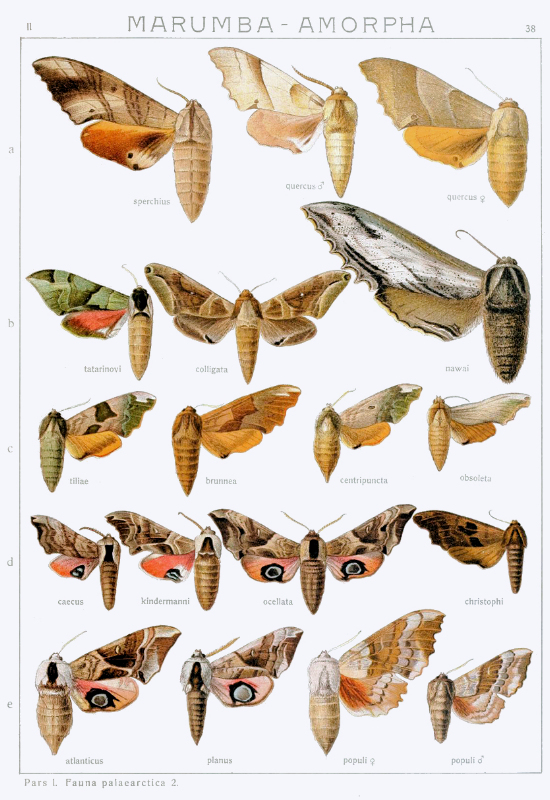
Holarctic; western Palaearctic region. Pleistocene refuge: Polycentric -- Syrian, Iranian, Turkestan and Sindian refugia.
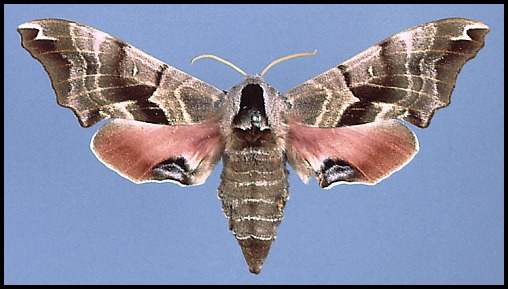
Wingspan: 70--80mm. Sexually dimorphic. Similar to Smerinthus ocellatus (Linnaeus), but forewing elongate, heavily dentate along the outer margin, with the cryptic pattern more distinct and outlined in light brown or buff. Abdominal segments fringed with white. There is very little variation, except between generations, the first being paler and lighter in colour. Populations from hot, arid areas are also redder and paler than those from cooler and moister regions, and are referable to as f. orbatus.
A fertile female captured in Ürümqi, Xinjiang, China in August 1995 was pale reddish-brown with weak markings. Her offspring over two years varied greatly in colouration and markings, depending on what temperature and humidity the developing pupae were kept at. Those kept cool and humid produced dark, well-marked, greyish adults with intense colours, identical to those from Turkey. Those kept hot and dry produced pale, reddish-brown, poorly-marked individuals with washed-out colours.
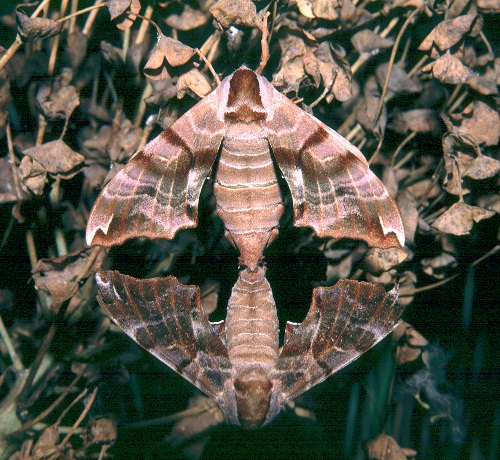
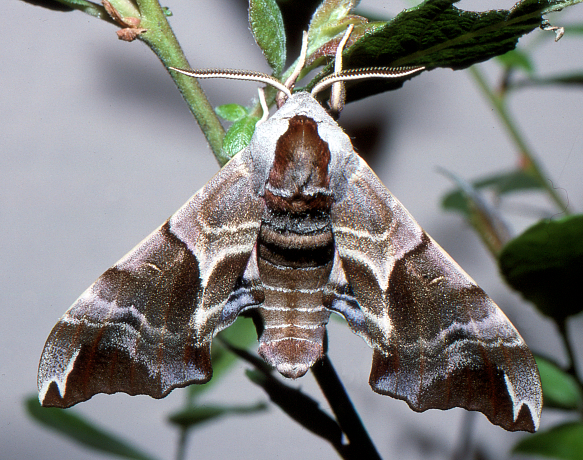
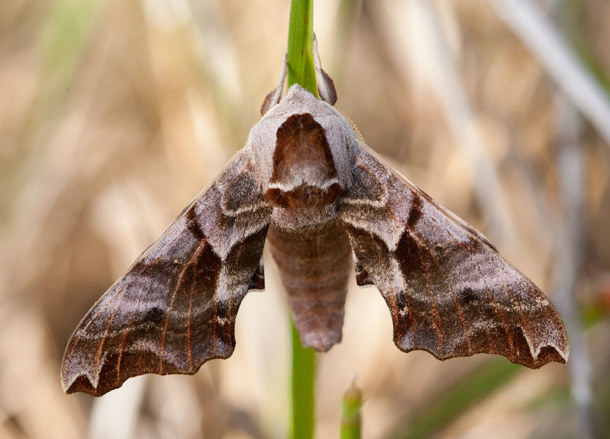
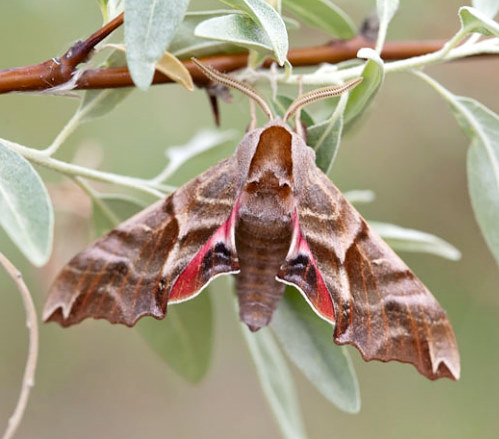
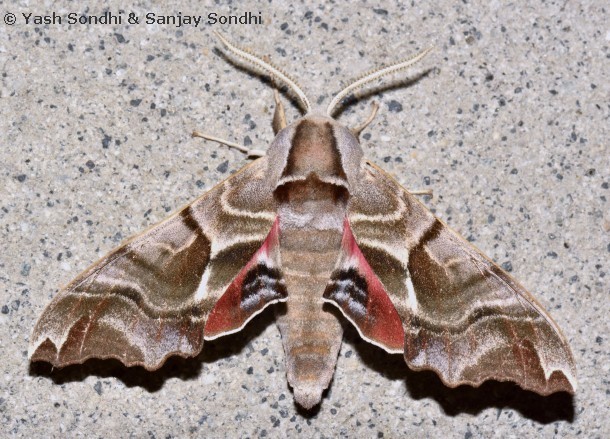
Frequents open forest, streams, plantation fringes and oases with Salix spp. (willows). In Mesopotamia, found almost anywhere where willows grow (Watkins & Buxton, 1923; Wiltshire, 1957); similar habitats are also frequented in Turkmenistan, Uzbekistan and Tajikistan (Shchetkin et al., 1988). In Iran, restricted to 1500--2000m along the Zagros and Alborz Mountains. In northern India (Jammu & Kashmir/Ladakh and Himachal Pradesh) at altitudes between 2960 to 4138m (Sidhu, Nair & Kubendran, 2018).
Most adults tend to emerge just before or even at day-break. In the Xinjiang population (China), most females call soon thereafter, with the males flying by day, often as late as mid morning. The pair remain in copula for a few hours or until dusk. This may be an adaptation to the very cold nights which can occur in this part of Central Asia.

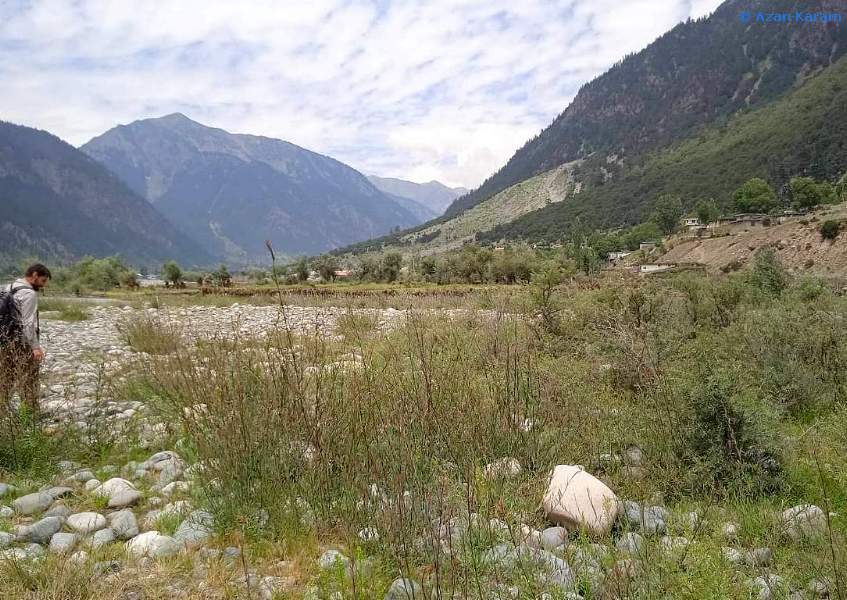
In northern Iran and northern Turkey, and at higher altitudes, during May and June as one generation. In Lebanon, between early June and mid-September in two overlapping generations. In Mesopotamia, central Iran, Turkmenistan, Uzbekistan and Tajikistan as three distinct generations -- March/April, May/June and August/September. At Kandahar, Afghanistan, recorded during June, July and August (Swinhoe, 1885). In most years there are two generations in northern Xinjiang, China -- May and July/August, but a cold late spring will result in only one, with adults emerging in June or even July.
OVUM: Similar to that of Smerinthus ocellatus and laid in similar locations. Those deposited by Xinjiang females are considerably larger than those laid by Turkish individuals, being similar in size those those of Laothoe populi.
LARVA: Full-fed 55--60mm. Dimorphic: fern-green or bluish grey.
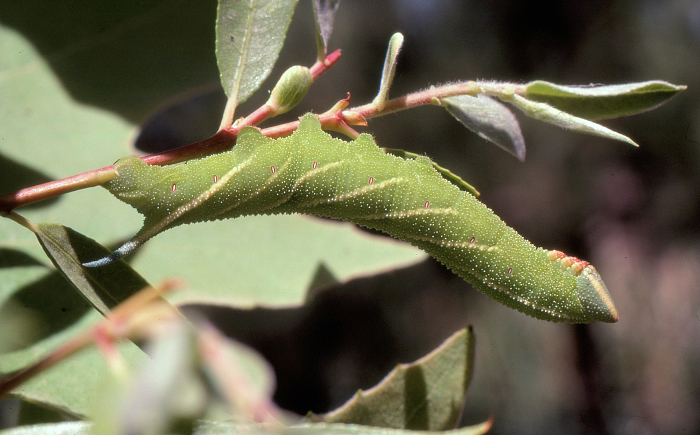
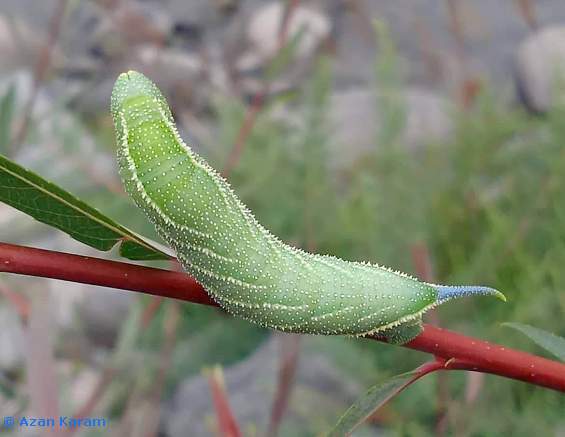
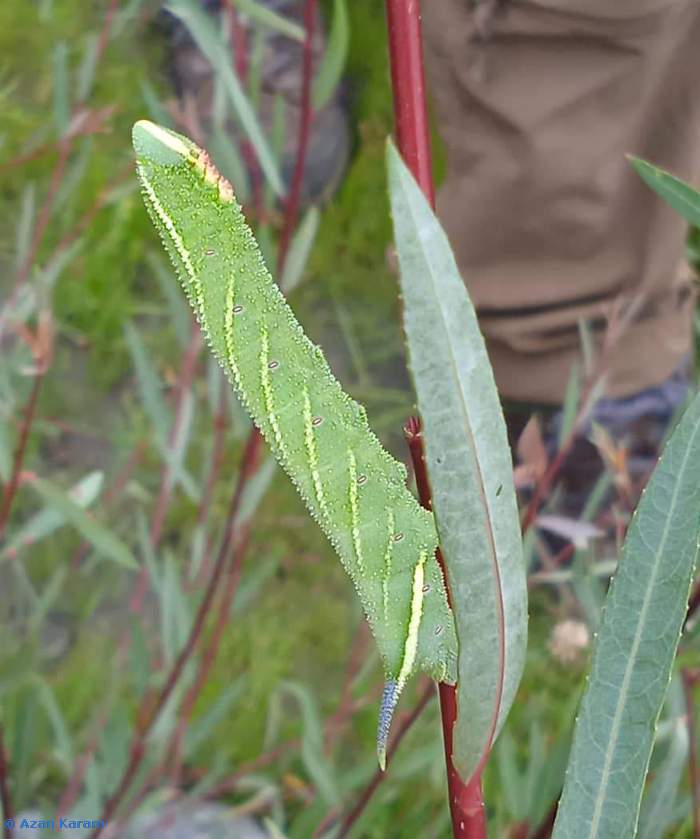
In colour and behaviour, very similar to Smerinthus ocellatus at all stages; however, of the two colour forms to be found, unlike Smerinthus ocellatus, the predominant one is primarily fern-green with yellow oblique side stripes (sometimes edged with red); the other is bluish grey with white markings. When fully grown, shorter and much more slender than Smerinthus ocellatus, with a stouter but less erect anal horn.
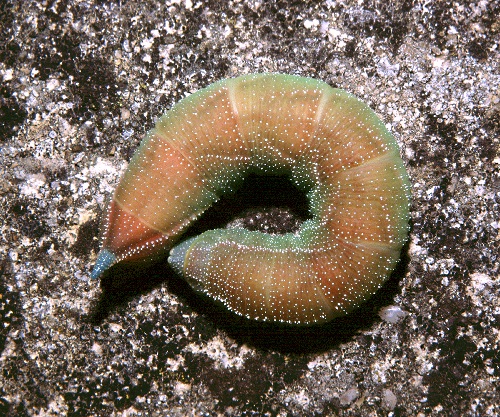
Found from April until October, depending on altitude and latitude.
Major Hostplants. Salix spp.
Minor Hostplants. Populus spp. (Shchetkin et al., 1988). Talhouk (1997) also lists Malus.
PUPA: 30--37mm. Deep mahogany brown, but otherwise resembling a short, slender Smerinthus ocellatus pupa. Pupation occurs at the base of the hostplant or, more often, some distance away under a grass tussock, 2--3cm under the surface of the soil within an earthen cell. The overwintering stage.
None recorded.
Not fully known within the western Palaearctic, but has been found as far west as Istanbul in northern Turkey and Konya/Marash in southern Turkey (Daniel, 1932; de Freina, 1979; Ayberk & Akkuzu, 2005; de Freina, 2012; Koçak & Kemal, 2018; Seven, 2020; Seven & Aykal, 2022), on Cyprus, in the Caucasus, the Republic of Georgia (Didmanidze, Petrov & Zolotuhin, 2013), Armenia (Dubatolov, [1999]; Didmanidze, Petrov & Zolotuhin, 2013; Wąsala & Zamorski, 2015), Azerbaijan (Didmanidze, Petrov & Zolotuhin, 2013; Snegovaya & Petrov, 2021), Syria (Talhouk, 1997), Lebanon (Zerny, 1933; Ellison & Wiltshire, 1939; Talhouk, 1997), Jordan (Müller et al., 2005a), Israel (Eisenstein, 1984; Müller et al., 2005b) and northern Iraq (Watkins & Buxton, 1923; Wiltshire, 1957; Kemal & Koçak, 2018c); then east to Mashhad (Kalali, 1976) and south to Shiraz (Iran) (Daniel, 1971; Ghassemi, Alemansoor & Alehossein, 2010). Also, Turkmenistan (Danov & Pereladov, 1985), Uzbekistan (Fergana Valley and Samarkand area) (Shermatov et al., 2021; Toropov, Milko, Zhdanko & Evdoshenko, 2023; Omonov, Rahimov, Askarova & Khomidova, 2023), Kyrgyzstan (Chatkal Mountains) (Korb, 2018; Toropov, Milko, Zhdanko & Evdoshenko, 2023), Kazakhstan (Shovkoon, 2015), northwestern China (Xinjiang) (Danner et al., 1998), Tajikistan (Shchetkin et al., 1988), north-east Afghanistan (Rothschild & Jordan, 1903; Ebert, 1969), eastern Afghanistan south and east of the Hindu Kush (Swinhoe, 1885; Ebert, 1969), northern Pakistan (Chitral; Tando Jam, Sindh Province (Panhwar et al., 2016)), Kashmir (Bell & Scott, 1937; Rafi et al., 2014), and north-west India (Jammu & Kashmir/Ladakh (Smetacek & Kitching, 2012; Sondhi, Sondhi, Roy & Kunte, 2021), Himachal Pradesh (Sidhu, Nair & Kubendran, 2018), and maybe Sikkim (Khan & Raina, 2017)). One specimen has been recorded from Kuwait (Kuwait University Collection) (Pittaway, 1993); this is indistinguishable from typical f. orbatus.
Extra-limital range. Western Mongolia (Yakovlev, Ustyuzhanin & Doroshkin, 2005), and north, central and southern Xinjiang Province to Ningxia and Gansu, China (Staudinger, 1901; Chu & Wang, 1980b; Danner et al., 1998; Pittaway & Kitching, 2000). Reports of this species from the Transbaikal area of Russia (Eversmann, 1854; Derzhavets, 1984) are erroneous and refer to the brown form of Callambulyx tatarinovii tatarinovii (Bremer & Grey, 1853).
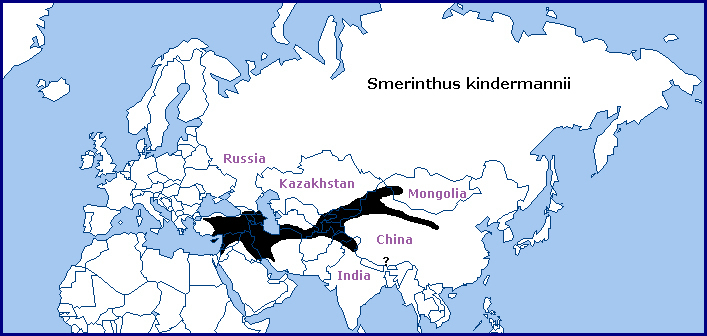
None.
 Return to species list
Return to species list